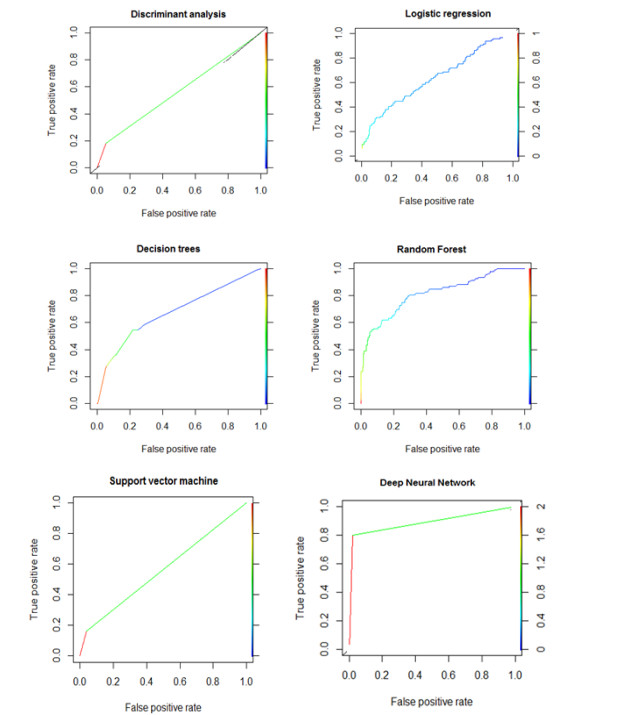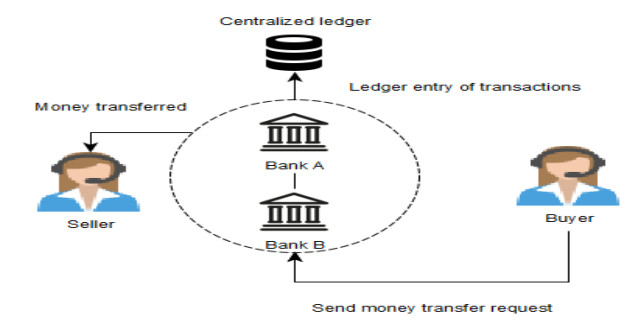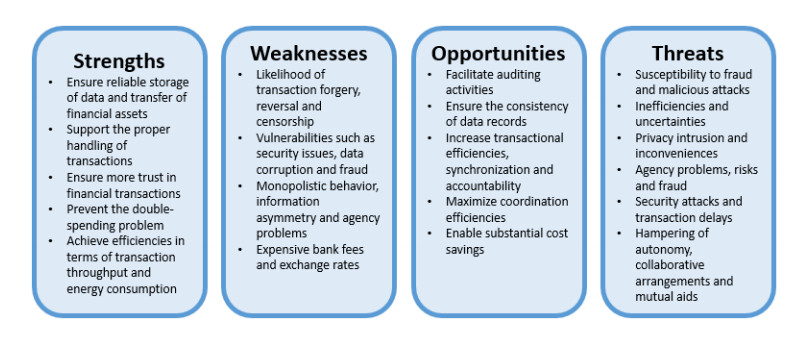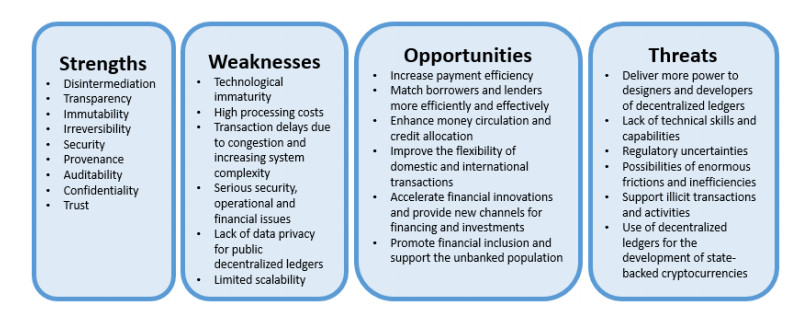|
[1]
|
Abadi J, Brunnermeier M (2018) Blockchain Economics. National Bureau of Economic Research. Working Paper No. 25407. Available from: https://doi.org/10.3386/w25407.
|
|
[2]
|
Adams B, Tomko M (2018) A Critical Look at Cryptogovernance of the Real World: Challenges for Spatial Representation and Uncertainty on the Blockchain (Short Paper), In: S. Winter A, Griffin, & M. Sester (Eds.), 10th International Conference on Geographic Information Science (GIScience 2018), Dagstuhl, Germany: Schloss Dagstuhl-Leibniz-Zentrum fuer Informatik, 18: 1-6.
|
|
[3]
|
Ainsworth RT, Magauran B (2018) Taxing & Zapping Marijuana: Blockchain Compliance in the Trump Administration Part 3, SSRN Scholarly Paper No. ID 3239977, Rochester, NY: Social Science Research Network. Available from: https://doi.org/10.2139/ssrn.3239977.
|
|
[4]
|
Allen DWE, Berg A, Berg C, et al. (2019) Some economic consequences of the GDPR, C/O John Conley, Department of Economics, 414 Calhoun Hall, Nashville, TN 37235 USA: Economics Bulletin.
|
|
[5]
|
Alqaryouti O, Siyam N, Alkashri Z, et al. (2020) Users' Knowledge and Motivation on Using Cryptocurrency, In: M. Themistocleous & M. Papadaki (Eds.), Information Systems, Cham: Springer International Publishing, 113-122.
|
|
[6]
|
Ammous SH (2016) Blockchain Technology: What is it Good for? SSRN Electron J. Available from: https://doi.org/10.2139/ssrn.2832751.
|
|
[7]
|
Andersson K, Styf A (2020) Blockchain Technology and Volatility of Stock Returns: A Quantitative Study that Examines Blockchain Technology's Impact on Volatility in Swedish Stocks. Master Thesis, Umeå University, Faculty of Social Sciences, Umeå School of Business and Economics (USBE), Business Administration, Sweden.
|
|
[8]
|
Arjani N (2007) Management of Foreign Exchange Settlement Risk at Canadian Banks. Financ Syst Rev 8: 71-78.
|
|
[9]
|
Arslan O, Er ID (2008) SWOT analysis for safer carriage of bulk liquid chemicals in tankers. J Hazard Mater 154: 901-913. doi: 10.1016/j.jhazmat.2007.10.113

|
|
[10]
|
Athanassiou P (2017) Impact of Digital Innovation on the Processing of Electronic Payments and Contracting: An Overview of Legal Risks. SSRN Scholarly Paper No. ID 3067222, Rochester, NY: Social Science Research Network.
|
|
[11]
|
Avouyi-Dovi S, Neto D (2004) Equity market interdependence: The relationship between European and US stock markets. Financ Stab Rev 4: 108-126.
|
|
[12]
|
Azgad-Tromer S (2018) Crypto Securities: On the Risks of Investments in Blockchain-Based Assets and the Dilemmas of Securities Regulation. Am Univ Law Rev 68: 69.
|
|
[13]
|
Bech ML, Garratt R (2017) Central Bank Cryptocurrencies. SSRN Scholarly Paper No. ID 3041906. Rochester, NY: Social Science Research Network. Available from: https://papers.ssrn.com/abstract=3041906.
|
|
[14]
|
Ben Dhaou SI, Rohman IK (2018) Everything and its opposite: Socio-economic implications of Blockchain technology: Case of monetary policy. Proceedings of the 11th International Conference on Theory and Practice of Electronic Governance, Galway, Ireland: Association for Computing Machinery, 631-639. Available from: https://doi.org/10.1145/3209415.3209502.
|
|
[15]
|
Bogucki B (2017) Buying Votes in the 21st Century: The Potential Use of Bitcoins and Blockchain Technology in Electronic Voting Reform. Asper Rev Int Bus Trade Law 17: 59.
|
|
[16]
|
Borah MD, Naik VB, Patgiri R, et al. (2020) Supply Chain Management in Agriculture Using Blockchain and IoT, In: S. Kim & G. C. Deka (Eds.), Advanced Applications of Blockchain Technology, Singapore: Springer, 227-242.
|
|
[17]
|
Brandon D (2016) The Blockchain: The Future of Business Information Systems? Int J Acad Bus World 10: 33-40.
|
|
[18]
|
Braun V, Clarke V (2006) Using thematic analysis in psychology. Qual Res Psychol 3: 77-101. doi: 10.1191/1478088706qp063oa

|
|
[19]
|
Burley RF (2018) Stable and decentralized? The promise and challenge of a shared citation ledger. Inf Serv Use 38: 141-148. doi: 10.3233/ISU-180017

|
|
[20]
|
Camera G (2017) A Perspective on Electronic Alternatives to Traditional Currencies, SSRN Scholarly Paper No. ID 2902721, Rochester, NY: Social Science Research Network. Available from: https://papers.ssrn.com/abstract=2902721.
|
|
[21]
|
Cappa F, Pinelli M (2020) Collecting money through blockchain technologies: First insights on the determinants of the return on Initial Coin Offerings. Inf Technol Dev, 1-18. doi: 10.1080/02681102.2020.1801564

|
|
[22]
|
Casey MJ, Vigna P (2018) In blockchain we trust. MIT Technol Rev 121:10-16.
|
|
[23]
|
Catalinz C, Gans JS (2016) Some Simple Economics of the Blockchain. Commun ACM 63: 80-90. doi: 10.1145/3359552

|
|
[24]
|
Cermeño JS (2016) Blockchain in financial services: Regulatory landscape and future challenges for its commercial application. BBVA Res Pap 16: 20.
|
|
[25]
|
Cha SC, Yeh KH (2018) An ISO/IEC 15408-2 Compliant Security Auditing System with Blockchain Technology. 2018 IEEE Conference on Communications and Network Security (CNS), 1-2.
|
|
[26]
|
Chandra GR, Liaqat IA, Sharma B (2019) Blockchain Redefining: The Halal Food Sector. 2019 Amity International Conference on Artificial Intelligence (AICAI), 349-354.
|
|
[27]
|
Chen CJ (2019) Developing a model for supply chain agility and innovativeness to enhance firms' competitive advantage. Manage Decis 57: 1511-1534. doi: 10.1108/MD-12-2017-1236

|
|
[28]
|
Chen J, Zhang X, Shangguan P (2020) Improved PBFT Algorithm Based on Reputation and Voting Mechanism. J Phys 1486: 032023.
|
|
[29]
|
Chen Y, Chou JS (2015) On the Privacy of "User Efficient Recoverable Off-Line E-Cash Scheme with Fast Anonymity Revoking". IJ Network Secur 17: 708-711.
|
|
[30]
|
Chen Y, Bellavitis C (2020) Blockchain disruption and decentralized finance: The rise of decentralized business models. J Bus Ventur Insights 13: e00151. doi: 10.1016/j.jbvi.2019.e00151

|
|
[31]
|
Chuen DLK, Guo L, Wang Y (2017) Cryptocurrency: A New Investment Opportunity? J Alternative Invest 20: 16-40. doi: 10.3905/jai.2018.20.3.016

|
|
[32]
|
Clohessy T, Acton T (2019) Investigating the influence of organizational factors on blockchain adoption: An innovation theory perspective. Ind Manage Data Syst 119: 1457-1491. doi: 10.1108/IMDS-08-2018-0365

|
|
[33]
|
Clohessy T, Acton T, Rogers N (2019) Blockchain Adoption: Technological, Organisational and Environmental Considerations, In: H. Treiblmaier & R. Beck (Eds.), Business Transformation through Blockchain: Volume I, Cham: Springer International Publishing, 47-76.
|
|
[34]
|
Coinmap (2020) Crypto ATMs & merchants of the world Coinmap.org. Available from: https://coinmap.org/.
|
|
[35]
|
Cointelegraph (2020) Where To Issue ICO Tokens: Platforms Review. Available from: https://cointelegraph.com/ico-101/where-to-issue-ico-tokens-platforms-review.
|
|
[36]
|
Cole R, Stevenson M, Aitken J (2019) Blockchain technology: Implications for operations and supply chain management. Supply Chain Manage Int J 24: 469-483. doi: 10.1108/SCM-09-2018-0309

|
|
[37]
|
Collomb A, Sok K (2016) Blockchain/distributed ledger technology (DLT): What impact on the financial sector? Digiworld Econ J 103: 93.
|
|
[38]
|
Compañó R, Bock AK, Burgelman JC, et al. (2006) Converging applications for active ageing policy. Foresight 8: 30-42. doi: 10.1108/14636680610656165

|
|
[39]
|
Corradini I (2020) The Digital Landscape, In: I. Corradini (Ed.), Building a Cybersecurity Culture in Organizations: How to Bridge the Gap Between People and Digital Technology, Cham: Springer International Publishing, 1-22.
|
|
[40]
|
Crosby M, Pattanayak P, Verma S, et al. (2016) Blockchain technology: Beyond bitcoin. Appl Innovation 2: 71.
|
|
[41]
|
Cumming DJ, Johan S, Pant A (2019) Regulation of the Crypto-Economy: Managing Risks, Challenges, and Regulatory Uncertainty. J Risk Financ Manage 12: 126. doi: 10.3390/jrfm12030126

|
|
[42]
|
Dai F, Shi Y, Meng N, et al. (2017) From Bitcoin to cybersecurity: A comparative study of blockchain application and security issues. 2017 4th International Conference on Systems and Informatics (ICSAI), 975-979. Available from: https://doi.org/10.1109/ICSAI.2017.8248427.
|
|
[43]
|
Davis J, Mengersen K, Bennett S, et al. (2014) Viewing systematic reviews and meta-analysis in social research through different lenses. SpringerPlus 3: 511. doi: 10.1186/2193-1801-3-511

|
|
[44]
|
Del Río CA (2017) Use of distributed ledger technology by central banks: A review. Enfoque UTE 8: 1-13.
|
|
[45]
|
Dolenc D, Turk J, Pustišek M (2020) Distributed Ledger Technologies for IoT and Business DApps. 2020 International Conference on Broadband Communications for Next Generation Networks and Multimedia Applications (CoBCom), 1-8. Available from: https://doi.org/10.1109/CoBCom49975.2020.9174188.
|
|
[46]
|
Donovan AP (2018) (Shadow) banking on the blockchain: Permissioned ledgers, interoperability and common standards, Research Handbook on Shadow Banking. Available from: https://www.elgaronline.com/view/edcoll/9781785362620/9781785362620.00020.xml.
|
|
[47]
|
Drašković T (2018) Blockchain at the European Level. Available from: https://dspace.cuni.cz/handle/20.500.11956/102359.
|
|
[48]
|
Drescher D (2017) Documenting Ownership, In: D. Drescher (Ed.), Blockchain Basics: A Non-Technical Introduction in 25 Steps, Berkeley, CA: Apress, 63-69. Available from: https://doi.org/10.1007/978-1-4842-2604-9_9.
|
|
[49]
|
Duan J, Zhang C, Gong Y, et al. (2020) A Content-Analysis Based Literature Review in Blockchain Adoption within Food Supply Chain. Int J Environ Res Public Health 17: 1784. doi: 10.3390/ijerph17051784

|
|
[50]
|
Duke A (2019) What Does the CISG Have to Say about Smart Contracts: A Legal Analysis. Chicago J Int Law 20: 141.
|
|
[51]
|
Erceg A, Damoska Sekuloska J, Kelić I (2020) Blockchain in the Tourism Industry-A Review of the Situation in Croatia and Macedonia. Informatics 7: 5. doi: 10.3390/informatics7010005

|
|
[52]
|
Erhardt KD (2017) Bismuth: A blockchain-based program for verifying responsible data usage, Thesis, Massachusetts Institute of Technology, Massachusetts Institute of Technology. Available from: https://dspace.mit.edu/handle/1721.1/119629.
|
|
[53]
|
Fan C, Ghaemi S, Khazaei H, et al. (2020) Performance Evaluation of Blockchain Systems: A Systematic Survey. IEEE Access 8: 126927-126950. doi: 10.1109/ACCESS.2020.3006078

|
|
[54]
|
Fasolato F, Raggio M (2018) ICO or crowdfunding? An empirical analysis of fundraising strategies[Laurea Magistrale/Specialistica]. Available from: https://www.politesi.polimi.it/handle/10589/145025.
|
|
[55]
|
Fernández-Caramés TM, Fraga-Lamas P (2019) A Review on the Application of Blockchain for the Next Generation of Cybersecure Industry 4.0 Smart Factories. arXiv: 1902.09604[Cs]. Available from: http://arXiv.org/abs/1902.09604.
|
|
[56]
|
Foley S, Karlsen JR, Putniņš TJ (2019) Sex, Drugs, and Bitcoin: How Much Illegal Activity Is Financed through Cryptocurrencies? Rev Financ Stud 32: 1798-1853. doi: 10.1093/rfs/hhz015

|
|
[57]
|
Fosso Wamba S, Kamdjoug K, Robert J, et al. (2020) Bitcoin, Blockchain, and FinTech: A Systematic Review and Case Studies in the Supply Chain. Prod Plann Control 31: 115-142. doi: 10.1080/09537287.2019.1631460

|
|
[58]
|
Frehe V, Mehmann J, Teuteberg F (2017) Understanding and assessing crowd logistics business models-using everyday people for last mile delivery. J Bus Ind Mark 32: 75-97. doi: 10.1108/JBIM-10-2015-0182

|
|
[59]
|
Freire J, Koop D, Santos E, et al. (2008) Provenance for computational tasks: A survey. Comput Sci Eng 10: 11-21. doi: 10.1109/MCSE.2008.79

|
|
[60]
|
Ganne E (2018) Can Blockchain revolutionize international trade? World Trade Organization.
|
|
[61]
|
Goodhart C (2011) The Basel Committee on Banking Supervision: A History of the Early Years 1974-1997, Cambridge University Press.
|
|
[62]
|
Green S (2018) Decentralized Agriculture: Applying Blockchain Technology in Agri-Food Markets. Available from: http://dx.doi.org/10.11575/PRISM/34952.
|
|
[63]
|
Gyamerah SA (2019) Modelling the volatility of Bitcoin returns using GARCH models. Quant Financ Econ 3: 739-753. doi: 10.3934/QFE.2019.4.739

|
|
[64]
|
Hackius N, Petersen M (2017) Blockchain in Logistics and Supply Chain: Trick or Treat? Digitalization in Supply Chain Management and Logistics: Proceedings of Hamburg International Conference of Logistics, 3-18.
|
|
[65]
|
Hackius N, Petersen M (2020) Translating High Hopes Into Tangible Benefits: How Incumbents in Supply Chain and Logistics Approach Blockchain. IEEE Access 8: 34993-35003. doi: 10.1109/ACCESS.2020.2974622

|
|
[66]
|
Härdle WK, Harvey CR, Reule RCG (2020) Understanding Cryptocurrencies. J Financ Econometrics 18: 181-208. doi: 10.1093/jjfinec/nbz033

|
|
[67]
|
Hautsch N, Scheuch C, Voigt S (2020) Building Trust Takes Time: Limits to Arbitrage in Blockchain-Based Markets. arXiv: 1812.00595[q-Fin]. Available from: http://arXiv.org/abs/1812.00595.
|
|
[68]
|
Healy NS, Christiansen EN (2016) Anti-Money Laundering and Counter-Terrorist Finance: Year-in-Review 2015. Int Lawyer 50: 423.
|
|
[69]
|
Hellani H, Samhat AE, Chamoun M, et al. (2018) On BlockChain Technology: Overview of Bitcoin and Future Insights. 2018 IEEE International Multidisciplinary Conference on Engineering Technology (IMCET), 1-8. Available from: https://doi.org/10.1109/IMCET.2018.8603029.
|
|
[70]
|
Helms MM, Nixon J (2010) Exploring SWOT analysis-where are we now? A review of academic research from the last decade. J Strategy Manage 3: 215-251. doi: 10.1108/17554251011064837

|
|
[71]
|
Hileman G, Rauchs M (2017) Global blockchain benchmarking study. Available from: https://j2-capital.com/wp-content/uploads/2017/11/GLOBAL-BLOCKCHAIN.pdf.
|
|
[72]
|
Hsieh YY, Vergne JP, Anderson P, et al. (2018) Bitcoin and the rise of decentralized autonomous organizations. J Organ Design 7: 14. doi: 10.1186/s41469-018-0038-1

|
|
[73]
|
Huang DY (2013) Profit-driven abuses of virtual currencies. Univ California, San Diego, 14.
|
|
[74]
|
Hughes A, Park A, Kietzmann J, et al. (2019) Beyond Bitcoin: What blockchain and distributed ledger technologies mean for firms. Bus Horiz 62: 273-281. doi: 10.1016/j.bushor.2019.01.002

|
|
[75]
|
Hughes S, Middlebrook S (2014) Regulating Cryptocurrencies in the United States: Current Issues and Future Directions. William Mitchell Law Rev 40: 814-848.
|
|
[76]
|
Iansiti M, Lakhani KR (2017) The truth about blockchain. Harv Bus Rev 95: 118-127.
|
|
[77]
|
Inghirami IE (2019) AIS in the Time of Blockchain.Living Digital Ecosyst Technol Organ Human Agency, 122-136.
|
|
[78]
|
Inghirami L (2019a) Accounting Information Systems: The Scope of Blockchain Accounting. ITAIS and MCIS 2019: A Joint Event: The 13th Mediterranean Conference on Information Systems and the 16th Conference of the Italian Chapter of AIS, 1-13. Italy. Available from: https://boa.unimib.it/handle/10281/250204.
|
|
[79]
|
Iqbal M, Matulevičius R (2019) Comparison of Blockchain-Based Solutions to Mitigate Data Tampering Security Risk, In: C. Di Ciccio, R. Gabryelczyk, L. García-Bañuelos, T. Hernaus, R. Hull, M. Indihar Štemberger, … M. Staples (Eds.), Business Process Management: Blockchain and Central and Eastern Europe Forum, Cham: Springer International Publishing, 13-28.
|
|
[80]
|
Jia K, Zhang F (2017) Between liberalization and prohibition: Prudent enthusiasm and the governance of Bitcoin/blockchain technology, In: Bitcoin and Beyond (Open Access), Routledge, 88-108.
|
|
[81]
|
Johnstone M (2018) Catch Me If You Can: Resolving Bitcoin Disputes with Class Actions. Can Class Action Rev 15: 45-73.
|
|
[82]
|
Joo J, Park J, Han Y (2021) Applications of Blockchain and Smart Contract for Sustainable Tourism Ecosystems, In: V. Suma, N. Bouhmala, & H. Wang (Eds.), Evolutionary Computing and Mobile Sustainable Networks, Singapore: Springer, 773-780.
|
|
[83]
|
Joshi AP, Han, M, Wang Y (2018) A survey on security and privacy issues of blockchain technology. Math Found Computing 1: 121. doi: 10.3934/mfc.2018007

|
|
[84]
|
Kamble SS, Gunasekaran A, Sharma R (2019) Modeling the blockchain enabled traceability in agriculture supply chain. Int J Inf Manage.[In press].
|
|
[85]
|
Kamilaris A, Fonts A, Prenafeta-Boldύ FX (2019) The rise of blockchain technology in agriculture and food supply chains. Trends Food Sci Technol 91: 640-652. doi: 10.1016/j.tifs.2019.07.034

|
|
[86]
|
Keogh JG, Dube L, Rejeb A, et al. (2020a) The Future Food Chain: Digitization as an Enabler of Society 5.0, In: D. Detwiler (Ed.), Building the Future of Food Safety Technology (1st Edition), London, Oxford, UK; San Diego, Cambridge, USA: Elsevier.
|
|
[87]
|
Keogh JG, Rejeb A, Khan N, et al. (2020b) Blockchain and GS1 Standards in the Food Chain: A Review of the Possibilities and Challenges, In: D. Detwiler (Ed.), Building the Future of Food Safety Technology (1st Edition), London, Oxford, UK; San Diego, Cambridge, USA: Elsevier.
|
|
[88]
|
Khatoon A (2020) A Blockchain-Based Smart Contract System for Healthcare Management. Electronics 9: 94. doi: 10.3390/electronics9010094

|
|
[89]
|
Khatri JK, Metri B (2016) SWOT-AHP Approach for Sustainable Manufacturing Strategy Selection: A Case of Indian SME. Global Bus Rev 17: 1211-1226. doi: 10.1177/0972150916656693

|
|
[90]
|
Kokkola T (2011) The payment system: Payments, securities and derivatives, and the role of the Eurosystem, European Central Bank.
|
|
[91]
|
Korea JoongAng Daily (2020)[Korea and the fourth industrial revolution < 10-2 Finance > ] The blockchain promises to be the ledger for all ledgers. Available from: http://koreajoongangdaily.joins.com/news/article/article.aspx?aid=3035044.
|
|
[92]
|
Kropotkin P (1970) Anarchism: A Collection of Revolutionary Writings, ed. R. Baldwin (Mineola, NY: Dover, 2005), 265.
|
|
[93]
|
Kuschpèta O (1978) The birth of the banking and credit system of the USSR, In: O. Kuschpèta (Ed.), The banking and credit system of the USSR, Boston, MA: Springer US, 23-47.
|
|
[94]
|
Lacity MC (2018) Addressing key challenges to making enterprise blockchain applications a reality. MIS Q Exec 17: 201-222.
|
|
[95]
|
Lafarre A, Elst CV der (2018) Legal tech and blockchain for corporate governance and shareholders. Research Handbook in Data Science and Law. Available from: https://www.elgaronline.com/view/edcoll/9781788111294/9781788111294.00015.xml,
|
|
[96]
|
Laroiya C, Saxena D, Komalavalli C (2020) Chapter 9-Applications of Blockchain Technology, In: S. Krishnan, V. E. Balas, E. G. Julie, Y. H. Robinson, S. Balaji, & R. Kumar (Eds.), Handbook of Research on Blockchain Technology, Academic Press, 213-243.
|
|
[97]
|
Leal F, Malheiro B, Veloso B, et al. (2020) Responsible processing of crowdsourced tourism data. J Sust Tourism, 1-21.
|
|
[98]
|
Learned EP (1969) Business Policy: Text and Cases, R. D. Irwin.
|
|
[99]
|
Lemma V (2020a) Fintech and Market-Based Financing, In: V. Lemma (Ed.), FinTech Regulation: Exploring New Challenges of the Capital Markets Union, Cham: Springer International Publishing, 77-141.
|
|
[100]
|
Lemma V (2020b) FinTech Regulation, In: Springer Books, Springer.
|
|
[101]
|
Lewis AN, Regan AC (2020) Enabling Paratransit and TNC Services with Blockchain Based Smart Contracts, In: K. Arai, S. Kapoor, & R. Bhatia (Eds.), Intelligent Computing, Cham: Springer International Publishing, 471-481.
|
|
[102]
|
Liang X, Shetty S, Tosh D, et al. (2017) ProvChain: A Blockchain-based Data Provenance Architecture in Cloud Environment with Enhanced Privacy and Availability. Proceedings of the 17th IEEE/ACM International Symposium on Cluster, Cloud and Grid Computing, Piscataway, NJ, USA: IEEE Press, 468-477. Available from: https://doi.org/10.1109/CCGRID.2017.8.
|
|
[103]
|
Liberati A, Altman DG, Tetzlaff J, et al. (2009) The PRISMA statement for reporting systematic reviews and meta-analyses of studies that evaluate health care interventions: Explanation and elaboration. J Clin Epid 62:e1-e34. doi: 10.1016/j.jclinepi.2009.06.006

|
|
[104]
|
Liu KH, Chang SF, Huang WH, et al. (2019) The Framework of the Integration of Carbon Footprint and Blockchain: Using Blockchain as a Carbon Emission Management Tool, In: A. H. Hu, M. Matsumoto, T. C. Kuo, & S. Smith (Eds.), Technologies and Eco-innovation towards Sustainability I: Eco Design of Products and Services, Singapore: Springer, 15-22.
|
|
[105]
|
Mainelli M, Smith M (2015) Sharing ledgers for sharing economies: An exploration of mutual distributed ledgers (aka blockchain technology). J Financ Perspect 3.
|
|
[106]
|
Malhotra J, Jadhav NN, Sachdeo-Bedi R, et al. (2020) Redefining Trust and Disinter-Mediation With Blockchain in E-Governance, In: I. Willliams (Ed.), Cross-Industry Use of Blockchain Technology and Opportunities for the Future, IGI Global, 18-38.
|
|
[107]
|
Mao M, Xiao H (2018) Blockchain-based Technology for Industrial Control System CyperSecurity. Atlantis Press, 903-907. Available from: https://doi.org/10.2991/ncce-18.2018.151.
|
|
[108]
|
Marks J (2019) Distributed Ledger Technologies and Corruption. Sci Technol Law Rev 20.
|
|
[109]
|
Markus I, Xu L, Subhod I, et al. (2019) DAcc: Decentralized Ledger based Access Control for Enterprise Applications. 2019 IEEE International Conference on Blockchain and Cryptocurrency (ICBC), 345-351. Available from: https://doi.org/10.1109/BLOC.2019.8751479.
|
|
[110]
|
McMillan J (2014) The End of Banking: Money, Credit, and the Digital Revolution, a Trouver.
|
|
[111]
|
Milutinovic M, He W, Wu H, et al. (2016) Proof of Luck: An Efficient Blockchain Consensus Protocol. Proceedings of the 1st Workshop on System Software for Trusted Execution, Trento, Italy: Association for Computing Machinery, 1-6. Available from: https://doi.org/10.1145/3007788.3007790.
|
|
[112]
|
Minn KT (2019) Towards Enhanced Oversight of "Self-Governing" Decentralized Autonomous Organizations: Case Study of the DAO and Its Shortcomings. J Intellect Prop Entertrainment Law 9: 139.
|
|
[113]
|
Mohamed H (2020) Implementing a Central Bank Issued Digital Currency with Economic Implications Considerations. Int J Islamic Econ Financ (IJIEF) 3: 51-74.
|
|
[114]
|
Molina JC, Delgado DT, Tarazona G (2019) Using Blockchain for Traceability in the Drug Supply Chain, In: L. Uden, I.-H. Ting, & J. M. Corchado (Eds.), Knowl Manage Organ, Springer International Publishing, 536-548.
|
|
[115]
|
Momtaz PP (2019) The Pricing and Performance of Cryptocurrency. Eur J Financ, 1-14.
|
|
[116]
|
Morgan JS (2017) What I Learned Trading Cryptocurrencies While Studying the Law. Univ Miami Int Comp Law Rev 25: 159.
|
|
[117]
|
Mylrea M (2019) Chapter 12-Distributed Autonomous Energy Organizations: Next-Generation Blockchain Applications for Energy Infrastructure, In: W. Lawless, R. Mittu, D. Sofge, I. S. Moskowitz, & S. Russell (Eds.), Artificial Intelligence for the Internet of Everything, Academic Press, 217-239.
|
|
[118]
|
Nabilou H (2019) Testing the waters of the Rubicon: The European Central Bank and central bank digital currencies. J Bank Regul.
|
|
[119]
|
Nair GR, Sebastian S (2017) Blockchain Technology; Centralised Ledger to Distributed Ledger. Intl Res J Eng Technol 4: 2823-2827.
|
|
[120]
|
Nakamoto S (2008) Bitcoin: A Peer-to-Peer Electronic Cash System. Available from: https://doi.org/10.1007/s10838-008-9062-0.
|
|
[121]
|
Natarajan H, Krause S, Gradstein H (2017) Distributed ledger technology and blockchain, World Bank.
|
|
[122]
|
Neuberger E (1959) Centralization vs. Decentralization: The Case of Yugoslav Banking. Am Slavic East Eur Rev 18: 361-373. doi: 10.2307/3004132

|
|
[123]
|
Nojoumian M, Golchubian A, Njilla L, et al. (2019) Incentivizing Blockchain Miners to Avoid Dishonest Mining Strategies by a Reputation-Based Paradigm, In: K. Arai, S. Kapoor, & R. Bhatia (Eds.), Intelligent Computing, Cham: Springer International Publishing, 1118-1134.
|
|
[124]
|
Pournader M, Shi Y, Seuring S, et al. (2019) Blockchain applications in supply chains, transport and logistics: A systematic review of the literature. Int J Prod Res, 1-19.
|
|
[125]
|
Queiroz MM, Wamba SF (2019) Blockchain adoption challenges in supply chain: An empirical investigation of the main drivers in India and the USA. Int J Inf Manage 46: 70-82. doi: 10.1016/j.ijinfomgt.2018.11.021

|
|
[126]
|
Rahmadika S, Ramdania DR, Harika M (2018) Security Analysis on the Decentralized Energy Trading System Using Blockchain Technology. J Online Inf 3: 44-47.
|
|
[127]
|
Raskin M, Yermack D (2018) Digital currencies, decentralized ledgers and the future of central banking, In: Research Handbook on Central Banking, Edward Elgar Publishing.
|
|
[128]
|
Rejeb A (2018a) Blockchain Potential in Tilapia Supply Chain in Ghana. Acta Technica Jaurinensis 11: 104-118. doi: 10.14513/actatechjaur.v11.n2.462

|
|
[129]
|
Rejeb A (2018b) Halal Meat Supply Chain Traceability Based on HACCP, Blockchain and Internet of Things. Acta Technica Jaurinensis 11: 1-30. doi: 10.14513/actatechjaur.v11.n1.407

|
|
[130]
|
Rejeb A, Bell L (2019) Potentials of Blockchain for Healthcare: Case of Tunisia. World Sci News 136: 173-193.
|
|
[131]
|
Rejeb A, Keogh JG, Treiblmaier H (2019a) Leveraging the Internet of Things and Blockchain Technology in Supply Chain Management. Future Int 11: 161. doi: 10.3390/fi11070161

|
|
[132]
|
Rejeb A, Keogh JG, Treiblmaier H (2019b) The impact of blockchain on medical tourism, WeB2019 Workshop on E-Business, Munich, Germany, 1-12.
|
|
[133]
|
Rejeb A, Keogh JG, Treiblmaier H (2020) How Blockchain Technology Can Benefit Marketing: Six Pending Research Areas. Front Blockchain 3: 1-12. doi: 10.3389/fbloc.2020.00003

|
|
[134]
|
Rejeb A, Rejeb K (2019) Blockchain Technology in Tourism: Applications and Possibilities. World Sci News, 119-144.
|
|
[135]
|
Rejeb A, Rejeb K (2020) Blockchain and supply chain sustainability. Logforum 16: 363-372. doi: 10.17270/J.LOG.2020.467

|
|
[136]
|
Rejeb A, Sűle E, Keogh JG (2018) Exploring new technologies in procurement. Transp Logistic Int J 18: 76-86.
|
|
[137]
|
Riehl JR, Ward J (2020) Transaction Pricing for Maximizing Throughput in a Sharded Blockchain Ledger. 2020 Crypto Valley Conference on Blockchain Technology (CVCBT), Rotkreuz, Switzerland, Switzerland: IEEE, 36-42. Available from: https://doi.org/10.1109/CVCBT50464.2020.00008.
|
|
[138]
|
Rosenfeld E (2015) Ecuador becomes the first country to roll out its own digital cash. CNBC February, 9.
|
|
[139]
|
Samavi R, Doyle TE, Topologlou T (2017) The first workshop on blockchain & amp; eHealth: Towards provable privacy & amp; security in data intensive health research. Proceedings of the 27th Annual International Conference on Computer Science and Software Engineering, USA: IBM Corp, 333-336.
|
|
[140]
|
Sarmah SS (2018) Understanding blockchain technology. Comput Sci Eng 8: 23-29.
|
|
[141]
|
Schär F (2020) Decentralized Finance: On Blockchain- and Smart Contract-based Financial Markets. SSRN Scholarly Paper No. ID 3571335. Rochester, NY: Social Science Research Network. Available from: https://doi.org/10.2139/ssrn.3571335.
|
|
[142]
|
Sheel A, Nath V (2019) Effect of blockchain technology adoption on supply chain adaptability, agility, alignment and performance. Manage Res Rev 42: 1353-1374. doi: 10.1108/MRR-12-2018-0490

|
|
[143]
|
Shu H, Qi P, Huang Y, et al. (2020) An Efficient Certificateless Aggregate Signature Scheme for Blockchain-Based Medical Cyber Physical Systems.Sensors 20: 1521. doi: 10.3390/s20051521

|
|
[144]
|
Singh V (2018) Understand Blockchain Technology: Your quick guide to understand blockchain concepts, Vivek Singh.
|
|
[145]
|
Snyder H (2019) Literature review as a research methodology: An overview and guidelines. J Bus Res 104: 333-339. doi: 10.1016/j.jbusres.2019.07.039

|
|
[146]
|
Stratfor (2020) The Arduous Task of Regulating Bitcoin. Available from: https://worldview.stratfor.com/article/arduous-task-regulating-bitcoin.
|
|
[147]
|
Subramanian N, Chaudhuri A, Kayikci Y (2020) Basics of Blockchain, In: N. Subramanian, A. Chaudhuri, & Y. Kayıkcı (Eds.), Blockchain and Supply Chain Logistics: Evolutionary Case Studies, Cham: Springer International Publishing, 11-19.
|
|
[148]
|
Suikkanen H (2017) Economic and Institutional Implications of Blockchain. Master Thesis, Aalto University, Finland. Available from: https://aaltodoc.aalto.fi:443/handle/123456789/28718.
|
|
[149]
|
Swan M (2015) Blockchain Blueprint for a New Economy, O'Reilly Media, Inc.
|
|
[150]
|
Tam MCY, Tummala VMR (2001) An application of the AHP in vendor selection of a telecommunications system. Omega 29: 171-182. doi: 10.1016/S0305-0483(00)00039-6

|
|
[151]
|
Tama BA, Kweka BJ, Park Y, et al. (2017) A critical review of blockchain and its current applications. 2017 International Conference on Electrical Engineering and Computer Science (ICECOS), Palembang: IEEE, 109-113. Available from: https://doi.org/10.1109/ICECOS.2017.8167115.
|
|
[152]
|
Tasca P, Tessone CJ (2018) Taxonomy of Blockchain Technologies. Principles of Identification and Classification. arXiv: 1708.04872[Cs]. Available from: http://arXiv.org/abs/1708.04872.
|
|
[153]
|
Tiwari STS, Chan SW, Ahmad MF, et al. (2019) Application and Implementation of E-Procurement Technologies in Malaysian Manufacturing Firm. Int J Supply Chain Manage 8: 923.
|
|
[154]
|
Treiblmaier H (2018) The impact of the blockchain on the supply chain: A theory-based research framework and a call for action. Supply Chain Manage Int J 23: 545-559. doi: 10.1108/SCM-01-2018-0029

|
|
[155]
|
Treiblmaier H (2019) Combining Blockchain Technology and the Physical Internet to Achieve Triple Bottom Line Sustainability: A Comprehensive Research Agenda for Modern Logistics and Supply Chain Management. Logistics 3: 1-13.
|
|
[156]
|
Treiblmaier H, Rejeb A, Strebinger A (2020) Blockchain as a Driver for Smart City Development: Application Fields and a Comprehensive Research Agenda.Smart Cities 3: 853-872. doi: 10.3390/smartcities3030044

|
|
[157]
|
Ureche O, Plamondon R (1999) Document transport, transfer and exchange: Security and commercial aspects. Proceedings of the Fifth International Conference on Document Analysis and Recognition. ICDAR 99 (Cat. No.PR00318), 585-588. Available from: https://doi.org/10.1109/ICDAR.1999.791855.
|
|
[158]
|
Visser C, Hanich QA (2017) How blockchain is strengthening tuna traceability to combat illegal fishing. Available from: https://ro.uow.edu.au/cgi/viewcontent.cgi?referer=&httpsredir= 1&article=4374&context=lhapapers.
|
|
[159]
|
Vujičić D, Jagodić D, Ranđić S (2018) Blockchain technology, bitcoin, and Ethereum: A brief overview. 2018 17th International Symposium INFOTEH-JAHORINA (INFOTEH), 1-6. Available from: https://doi.org/10.1109/INFOTEH.2018.8345547.
|
|
[160]
|
Wang L, Liu Y (2015) Exploring Miner Evolution in Bitcoin Network, In: J. Mirkovic & Y. Liu (Eds.), Passive and Active Measurement, Cham: Springer International Publishing, 290-302.
|
|
[161]
|
Wang S, Ouyang L, Yuan Y, et al. (2019) Blockchain-Enabled Smart Contracts: Architecture, Applications, and Future Trends. 445 Hoes Lane, Piscataway, NJ 08855-4141 USA: IEEE. Available from: https://doi.org/10.1109/TSMC.2019.2895123.
|
|
[162]
|
Wang Y, Kogan A (2018) Designing confidentiality-preserving Blockchain-based transaction processing systems. Int J Accounting Inf Syst 30: 1-18. doi: 10.1016/j.accinf.2018.06.001

|
|
[163]
|
Weihrich H (1982) The TOWS matrix-A tool for situational analysis. Long Range Plann 15: 54-66. doi: 10.1016/0024-6301(82)90120-0

|
|
[164]
|
Wessel D (2016) The Hutchins Center Explains: How blockchain could change the financial system (part 1). Available from: https://www.brookings.edu/blog/up-front/2016/01/11/the-hutchins-center-explains-how-blockchain-could-change-the-financial-system-part-1/.
|
|
[165]
|
Wiatt RG (2019) From the mainframe to the blockchain. Strat Financ 100: 26-35.
|
|
[166]
|
Wilson C (2019) Cryptocurrencies: The Future of Finance? In: F.-L. T. Yu & D. S. Kwan (Eds.), Contemporary Issues in International Political Economy, Singapore: Springer, 359-394.
|
|
[167]
|
Wright D (2002) Comparative Evaluation Of Electronic Payment Systems. INFOR Inf Syst Oper Res 40: 71-85.
|
|
[168]
|
Wu Z, Williams AB, Perouli D (2019) Dependable Public Ledger for Policy Compliance, a Blockchain Based Approach. 2019 IEEE 39th International Conference on Distributed Computing Systems (ICDCS), 1891-1900. Available from: https://doi.org/10.1109/ICDCS.2019.00187.
|
|
[169]
|
Xu L, Chen L, Gao Z, et al. (2020) DIoTA: Decentralized-Ledger-Based Framework for Data Authenticity Protection in IoT Systems. 445 Hoes Lane, Piscataway, NJ 08855-4141 USA: IEEE. Available from: https://doi.org/10.1109/MNET.001.1900136.
|
|
[170]
|
Xu Z, Zou C (2020) What can blockchain do and Cannot do? China Econ J, 1-22. doi: 10.1080/17538963.2020.1748968

|
|
[171]
|
Yau J (2001) The Inefficient Stock Market: What Pays Off and Why. J Altern Invest 4: 73-74. doi: 10.3905/jai.2001.319015

|
|
[172]
|
Yiannas F (2018) A New Era of Food Transparency Powered by Blockchain. Innovations Technol Governance Globalization 12: 46-56. doi: 10.1162/inov_a_00266

|
|
[173]
|
Yli-Huumo J, Ko D, Choi S, et al. (2016) Where Is Current Research on Blockchain Technology?-A Systematic Review. PLOS ONE 11: e0163477. doi: 10.1371/journal.pone.0163477

|
|
[174]
|
Yu Y, Li Y, Tian J, et al. (2018) Blockchain-Based Solutions to Security and Privacy Issues in the Internet of Things. IEEE Wireless Commun 25: 12-18. doi: 10.1109/MWC.2017.1800116

|
|
[175]
|
Zetzsche DA, Buckley RP, Arner DW (2018) The distributed liability of distributed ledgers: Legal risks of blockchain. U Ill L Rev, 1361.
|
|
[176]
|
Zheng Z, Xie S, Dai H, et al. (2017) An Overview of Blockchain Technology: Architecture, Consensus, and Future Trends. 2017 IEEE International Congress on Big Data (BigData Congress), 557-564. Available from: https://doi.org/10.1109/BigDataCongress.2017.85.
|
|
[177]
|
Zhou Z, Liu X, Pei J, et al. (2018) Competition of pricing and service investment between iot-based and traditional manufacturers. J Ind Manage Optim 14: 1203-1218.
|










 DownLoad:
DownLoad:







